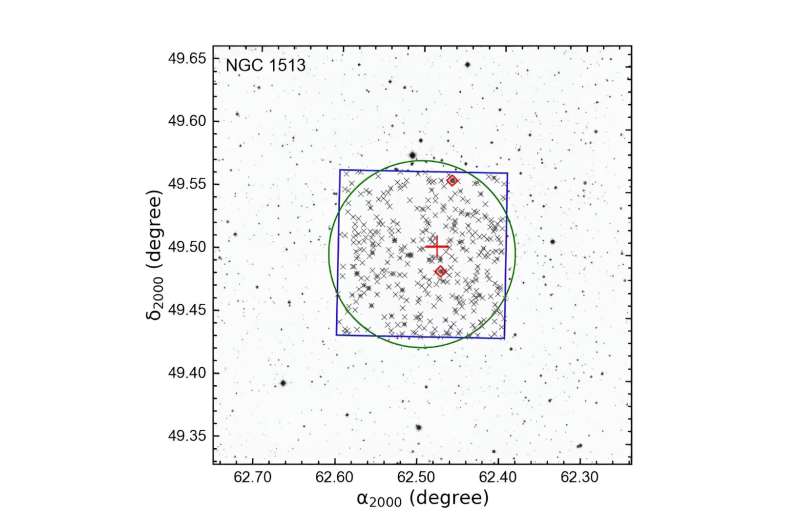May 24, 2024 report
This article has been reviewed according to Science X's editorial process and policies. Editors have highlighted the following attributes while ensuring the content's credibility:
fact-checked
preprint
trusted source
proofread
Observations explore open cluster NGC 1513

Using the National Astronomical Observatory (OAN) in Mexico, astronomers have observed an open cluster known as NGC 1513. Results of the observations, presented in a paper published May 16 on the pre-print server arXiv, yield crucial information regarding the properties of this cluster.
Open clusters (OCs), formed from the same giant molecular cloud, are groups of stars loosely gravitationally bound to each other. So far, more than 1,000 of them have been discovered in the Milky Way, and scientists are still looking for more, hoping to find a variety of these stellar groupings. Studying OCs in detail could be crucial for improving our understanding of the formation and evolution of our galaxy.
Discovered in 1790, NGC 1513 is an OC in the constellation Perseus, located some 4,800 light years away from the Earth. The cluster, which is estimated to be 363 million years old, has a tidal radius of about 65 light years and its metallicity was found to be at a level of -0.1 dex.
A team of astronomers led by İnci Akkaya Oralhan of the Erciyes University in Kayseri, Turkey, decided to take a closer look at NGC 1513. They employed one of the optical telescopes at OAN to investigate the properties of this cluster.
"Observation of NGC 1513 cluster and some Landolt standard fields were carried out at the Sierra San Pedro Mártir National Astronomical Observatory during the very photometric nights of December 3–5, 2023 UT using the 0.84-m (f/15) Ritchey-Chretien telescope equipped with the Mexman filter wheel and a detector," the researchers explained.
The observations found that NGC 1513 has a core radius of about 6.39 light years, while its half-light radius is approximately 7.63 light years. This means that the cluster has a relatively high core radius to half-light radius ratio—at a level of 0.82. The astronomers assume that such a high ratio is probably related to cluster-formation effects due to its little dynamical evolution.
Based on the new results, it was found that NGC 1513 is dynamically relaxed as its relaxation age was calculated to be 22.3 million years, while its age was determined to be some 224 million years. The cluster's metallicity was measured to be -0.06 dex.
At least 457 members of NGC 1513 have been identified, with masses ranging from 1.12 to 3.98 solar masses. The total mass of the cluster was found to be 624.7 solar masses, which yields a mean mass for the member stars of approximately 1.37 solar masses. The authors of the paper noted that NGC 1513 presents a sign of small-scale mass segregation with little dynamical evolution.
According to the study, NGC 1513 is at a distance of 4,935 light years and must have migrated about 1,400 light years from its birth place. In general, the cluster follows a circular path around the Milky Way's center and has almost made one revolution around the center of the galaxy.
More information: İnci Akkaya Oralhan et al, CCD ????????????(????????)???????? photometry and dynamics of the open cluster NGC 1513, arXiv (2024). DOI: 10.48550/arxiv.2405.09918
Journal information: arXiv
© 2024 Science X Network




















